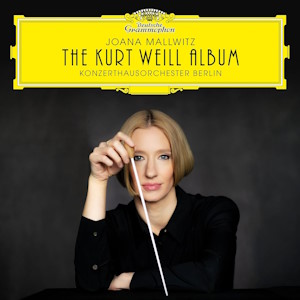
Kurt Weill (1900-1950)
The Kurt Weill Album
Symphony No 1 ‘Berliner Sinfonie’ (1921)
Die sieben Todsünden (1933)
Symphony No 2 (1933/1934)
Katharine Mehrling (singer), Konzerthausorchester Berlin/Joana Mallwitz
rec. 2024, Konzerthaus, Berlin, Germany
Texts and translations not supplied
Reviewed as a FLAC 16bit download
Deutsche Grammophon 4865670 [82]
This new Kurt Weill album by rising star Joana Mallwitz and her Konzerthausorchester Berlin recorded in wonderful sound and issued with useful documentation by Deutsche Grammophon is tempting. We are offered both symphonies in their new critical editions in thought-through, considered readings, as well as a performance of the masterful Die Sieben Todsünden by an experienced principal of the Berlin stage.
Most UK teenagers these days studying GCSE History will be able to tell you much about the Weimar Republic, that period of chaotic democracy in Germany spanning the interwar period of the 1920s and early 1930s. Those students can no doubt wax lyrical about the achievements of Gustav Stresemann in bringing reason and stability to those troubled times whilst noting too the stages that led to the political fragmentation after 1932 and the eventual rise to power of you know who.
Unfortunately for them, they probably do not have time to study the culture of those momentous times. The Weimar Republic was the birthplace of expressionist cinema. Maybe Weill saw the film The Cabinet of Dr Caligari (1920) whilst studying as one of Busoni’s five specially picked “Master-Students” in Berlin. Certainly, the period of hyper-inflation in 1923 will be on the syllabus for today’s GCSEs but the hard-working history student probably knows little of the Bauhaus project or the incredible success of Brecht and Weill with Die Dreigroschenoper in 1928.
The Berlin of the 1920s and early 1930s was a Golden Metropolis for sure, albeit with huge social contrasts, daily (and nightly) upheavals; this record captures some of that, I think.
Joana Mallwitz’s first concert with her new orchestra was broadcast throughout Germany and included three First Symphonies: by Prokofiev, Weill and Mahler. I have a recording of that concert (snippets are also on Youtube). Weill’s Symphonie in einem Satz is programmed first here. This early work is infused with Late Romantic influences and the orchestration is influenced by Schoenberg. The piece is full of ideas; as you might expect, not all of these are developed with the skill Weill would use 13 years later in his follow-up work.
Mallwitz opts for a fairly large band in both symphonies and an orchestral arrangement which places the violas on the right with cellos in the middle. Woodwind comes across wonderfully in both symphonies and there is lovely phrasing throughout.
By the time Weill penned his Second Symphony, he had left Germany and was domiciled in Paris. The performance here is pacey and punchy. Trumpet and trombone shine in their prominent roles in the first and second movements, and throughout the balance between strings and wind is wonderfully caught by the engineers. At the time of writing in 1933, over in the Soviet Union Shostakovich was penning his Concerto for Piano and Trumpet. There are definite places in the score where we are reminded of the Russian composer. HK Gruber calls Weill’s second movement Cortege a “Trauer-Tango”. His performance with the Swedish Chamber orchestra in 2021 is insightful but for me the greatest performances of this last orchestral work from Weill are by Mariss Jansons with the BPO in 1997 and, more recently, a beautiful, intelligent reading by Lahav Shani and the Rotterdam PO in 2018.
Weill was the darling of the left-leaning intellectual set in Paris. Most Parisians were bewildered by The Seven Deadly Sins. It had its premiere in 1933 and was the last occasion on which he worked with Brecht. Its satirical plot of Anna making her fortune on a tour of seven cities – as told by her alter ego and commented upon frequently and sanctimoniously by her family – proves a memorable vehicle for Weill’s genius.
Lotte Lenya took her creator role into the Hamburg Studios in 1956. The line was transposed way down and set the tone for the low-voice Annas of which this is the most recent. Katharine Mehrling is fully on top of her brief. She has recent pedigree in this piece, having performed it in Berlin as recently as 2022 with Vladimir Jurowski and his RSO Berlin.
The problem for me is that I prefer the higher sung line to the lower Sprechgesang alternative. In preparing this review I returned to Anne Sofie von Otter’s gorgeously sung version with Gardiner (1993), to Brigitte Fassbaender (1992) and to my own favourite, Elisa Ross with the CBSO and Rattle (1983). The Ross/Rattle EMI recording has been re-issued on CD at various times. It was the first time the original scoring was recorded. It represents for me an ideal. Incidentally Rattle loves Weill. He was at the Barbican relatively recently with Magdalena Kožená in this very piece. I would not bet it will be too long before his new audience in Munich get to hear him in this music.
Katharine Mehrling can more appropriately be compared with Ute Lemper, whose recording was made a month before the fall of the Berlin Wall in the city itself. Lemper, like Mehrling, was a master of this genre and both versions can be considered echt.
This album is Joana Mallwitz’s impressive recording debut. She is due to conduct Le nozze di Figaro at the Met next Spring, having already done so to good notices at Covent Garden. Her next disc for DG will be Haydn’s Creation.
Philip Harrison
Buying this recording via a link below generates revenue for MWI, which helps the site remain free



















